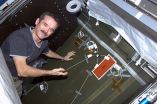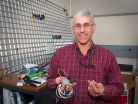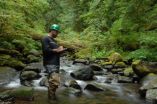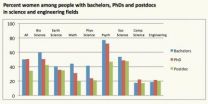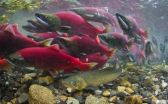HAMPTON, VA, March 21, 2013 (Press-News.org) The hiss of air escaping from a leaky car tire is no one's favorite sound.
Even less pleasant? Hearing that hiss of escaping air 250 miles above Earth's surface while inside the pressurized confines of the International Space Station.
According to Eric Madaras, an aerospace technologist at NASA's Langley Research Center in Hampton, Va., if an air leak were to occur aboard the station, alarms would sound, and the astronauts would locate and correct the problem according to procedures. But with only the crew's eyes and ears to go on, pinpointing the source of a leak could be tricky.
Madaras is trying to fix that problem. As the principal investigator for the Ultrasonic Background Noise Test (UBNT) he's leading a study that potentially could help prevent a catastrophic loss of air pressure on a crewed spacecraft.
By observing the high-frequency noise levels generated by hardware and equipment operating in the Destiny laboratory and Tranquility module aboard the space station, Madaras and his team are helping to develop an automated system that would locate air leaks in a space structure's pressure wall -- the outside part of the orbiting laboratory that keeps in oxygen.
"If a leak does occur, it's one of those things where you may not have a lot of time," Madaras said. "These guys can always go sit in the Soyuz capsule and close the door and go home. They've got that capability. But no one wants to just abandon ship, so there's always this desire to deal with it."
But dealing with a leak means identifying the source. Right now, that would require someone to listen for the signature hiss of escaping air -- not an easy or quick task, especially on a noisy space station that has structures covering the wall where the leak might originate.
That's why, as part of UBNT, astronauts are in the process of installing several distributed impact detection system (DIDS) units on the pressure walls of the space station. DIDS units are high-speed, four-channel digitizers that record ultrasonic noises. Instead of listening for the hiss of air, these units detect the high-frequency sounds moving through the metal itself. Each unit has four pressure-sensitive transducers, which Madaras compares to the pickup coils on an electric guitar.
"That's where the rubber meets the road," Madaras said. "[The transducer] would essentially be stuck on the surface and anything that moves the surface up or down would be picked up."
Fourteen DIDS units will be installed aboard the space station: seven in Destiny and seven in Tranquility.
If all goes according to plan, and Madaras and his UBNT team are able to identify and characterize the day-to-day background noises on the orbiting outpost, they then will be able to develop a system that can pick out leak-generated noises from the clutter.
"One way to look at that is to think about a cocktail party," Madaras said. "It's sometimes very hard to hear people, even near you, because of all the background noises. That's the same phenomenon that this has got to deal with. How do you get that cleaned up so that you can hear specifically the type of noise -- the signal -- that you're looking for?"
The ability to locate pressure leaks in this way may have applications on Earth. According to Madaras, systems like the one he's working on could be useful when dealing with large pressure vessels containing critical material, like radioactive water at a nuclear plant.
Right now, though, the focus of the research is on providing the crew aboard the space station with a useful tool, one that may give an astronaut just enough advanced warning to patch a leak and save a module from being permanently closed off.
"The idea of giving them more time, trying to help them out and get that part done so they can get to the leak, and now they have the tools to fix the leak," Madaras said. "That, to me, would be a good deal."
For more about the International Space Station or information on past, ongoing, and future ISS research activities, including research results and publications, visit:
http://www.nasa.gov/mission_pages/station/main/index.html
If you are interested in subscribing to updates from the ISS Program Science Office, visit:
https://lists.nasa.gov/mailman/listinfo/iss-program-science-group
For more information on NASA's Langley Research Center, visit: re information on NASA's Langley Research Center, visit:
www.nasa.gov/langley
International Space Station Technology to "Hear" Potential Leaks
Release: JR13-021
2013-03-21
ELSE PRESS RELEASES FROM THIS DATE:
The GRLI Announces a Strategic Alliance with EFMD and AACSB International
2013-03-21
The agreement will see two of the most influential global voices in management education working closely with the GRLI, a network of forward thinking companies and business schools, to focus on an important message: that business and business schools need to work collectively to devote greater attention to developing responsible companies and leaders in the future.
Mark Drewell, CEO of the GRLI said, "Over the past nine years we have learnt a great deal about catalysing change in the complex interface between management education, business and society. This move ...
Study looks at longevity of total knee replacements in younger patients with juvenile arthritis
2013-03-20
When you think of knee replacement surgery, you generally envision an older adult with painful arthritis. But the procedure is also used for younger patients with juvenile idiopathic arthritis (JIA) whose joints have been severely damaged by the disease. Because the surgery in younger patients is relatively rare, little data exist on the longevity of knee replacements in JIA patients.
An international, multi-center study led by researchers at Hospital for Special Surgery (HSS) has found that total knee replacements in younger patients with juvenile arthritis last at ...
Study finds tiny, targeted drug particles may be effective in treating chronic diseases
2013-03-20
Doses of medicine 100,000 times smaller than the diameter of a human hair prevent the tissue damage associated with atherosclerosis and other chronic diseases in mice. As part of a National Institutes of Health-sponsored project led by Zahi Fayad, PhD, of the Icahn School of Medicine at Mount Sinai, researchers found that these nanomedicines are able to home specifically to damaged tissue to repair it. This study was published online this week in Proceedings of the National Academy of Sciences.
Inflammation is the body's natural defense mechanism against invading organisms ...
Study explores long-term water quality trends in near-pristine streams
2013-03-20
For the first time, a study has compared water quality trends in forested streams across the country that are largely undisturbed by land use or land cover changes.
The study, which draws on decades' worth of data from reference streams in six U.S. states and Puerto Rico, underscores the value of long-term data in understanding the patterns and causes of water quality changes in streams and rivers. It is published in the current issue of the journal Environmental Research Letters.
"Much of what we know about changes in stream water quality comes from studies where ...
Ben-Gurion U. researchers and Teva Pharmaceutical Industries Ltd. develop psoriasis drug
2013-03-20
BEER-SHEVA, Israel, March 20, 2013 -- Ben-Gurion University of the Negev (BGU) researchers, in collaboration with Teva Pharmaceutical Industries Ltd., have developed a promising drug candidate to treat psoriasis. The finding was reported in a new paper published in Chemistry and Biology.
Psoriasis is a chronic, non-contagious disease characterized by inflamed lesions covered with silvery-white scabs of dead skin. An auto-immune disease, psoriasis affects at least four million Americans. It is caused by the disturbance in the natural balance between pro-inflammatory signals ...
'End of men'? Not even close
2013-03-20
It's March 2013 – 50 years after Betty Friedan's explosive book launched feminism's "second wave," 41 after Title IX, the equal-opportunity amendment banning sex discrimination in education, was signed into law – and some exceptionally successful women are making a lot of news. Former U.S. Secretary of State Hillary Clinton is riding high in public opinion, winning straw polls for the 2016 presidency. Yahoo CEO Marissa Mayer, after shrugging off maternity leave, has sparked the "Great Telecommuting Debate" with a company-wide ban on working from home. And Sheryl Sandberg, ...
Mechanical forces play key role in assembly and disassembly of an essential cell protein
2013-03-20
Researchers have for the first time demonstrated that mechanical forces can control the depolymerization of actin, a critical protein that provides the major force-bearing structure in the cytoskeletons of cells. The research suggests that forces applied both externally and internally may play a much larger role than previously believed in regulating a range of processes inside cells.
Using atomic force microscopy (AFM) force-clamp experiments, the research found that tensile force regulates the kinetics of actin dissociation by prolonging the lifetimes of bonds at low ...
SMU Lyle School of Engineering course sparks CCL study
2013-03-20
DALLAS (SMU) – The Innovation Gym in SMU's Lyle School of Engineering was buzzing and clanking on a recent morning as students tested robots they built for a specific task – collecting and remediating water samples, as Lyle faculty and students have been doing by hand in refugee camps in Africa and Bangladesh.
The strong work dynamic that emerged among members of the first-year design class and their embrace of the inter-disciplinary team approach used to teach it has drawn the attention of the Center For Creative Leadership, which will send a team of researchers to ...
Altered brain activity responsible for cognitive symptoms of schizophrenia
2013-03-20
Cognitive problems with memory and behavior experienced by individuals with schizophrenia are linked with changes in brain activity; however, it is difficult to test whether these changes are the underlying cause or consequence of these symptoms. By altering the brain activity in mice to mimic the decrease in activity seen in patients with schizophrenia, researchers reporting in the Cell Press journal Neuron on March 20 reveal that these changes in regional brain activity cause similar cognitive problems in otherwise normal mice. This direct demonstration of the link between ...
Some Alaskan trout use flexible guts for the ultimate binge diet
2013-03-20
Imagine having a daylong Thanksgiving feast every day for a month, then, only pauper's rations the rest of the year.
University of Washington researchers have discovered Dolly Varden, a kind of trout, eating just that way in Alaska's Chignik Lake watershed.
Organs such as the stomach and intestines in the Dolly Varden doubled to quadrupled in size when eggs from spawning sockeye salmon became available each August, the researchers found. They were like vacuums sucking up the eggs and nipping at the flesh of spawned-out salmon carcasses.
Then, once the pulse of eggs ...
LAST 30 PRESS RELEASES:
University of Oklahoma researcher awarded funding to pursue AI-powered material design
Exploring how the visual system recovers following injury
Support for parents with infants at pediatric check-ups leads to better reading and math skills in elementary school
Kids’ behavioral health is a growing share of family health costs
Day & night: Cancer disrupts the brain’s natural rhythm
COVID-19 vaccination significantly reduces risk to pregnant women and baby
The role of vaccination in maternal and perinatal outcomes associated with COVID-19 in pregnancy
Mayo Clinic smartwatch system helps parents shorten and defuse children's severe tantrums early
Behavioral health spending spikes to 40% of all children’s health expenditures, nearly doubling in a decade
Digital cognitive behavioral treatment for generalized anxiety disorder
Expenditures for pediatric behavioral health care over time and estimated family financial burden
Air conditioning in nursing homes and mortality during extreme heat
The Alps to lose a record number of glaciers in the next decade
What makes a good proton conductor?
New science reporting guide published for journalists in Bulgaria
New international study reveals major survival gaps among children with cancer
New science reporting guide published for journalists in Turkey
Scientists develop a smarter mRNA therapy that knows which cells to target
Neuroanatomy-informed brain–machine hybrid intelligence for robust acoustic target detection
Eight SwRI hydrogen projects funded by ENERGYWERX
The Lundquist Institute and its start-up company Vitalex Biosciences Announces Strategic Advancement of Second-Generation fungal Vaccine VXV-01 through Phase 1 Trials under $40 Million Competitive Con
Fine particles in pollution are associated with early signs of autoimmune disease
Review article | Towards a Global Ground-Based Earth Observatory (GGBEO): Leveraging existing systems and networks
Penn and UMich create world’s smallest programmable, autonomous robots
Cleveland researchers launch first major study to address ‘hidden performance killer’ in athletes
To connect across politics, try saying what you oppose
Modulating key interaction prevents virus from entering cells
Project explores barriers to NHS career progression facing international medical graduates
Jeonbuk National University researchers explore the impact of different seasonings on the flavor perception of Doenjang soup
Two Keck Medicine of USC Hospitals named Leapfrog Top Teaching Hospitals
[Press-News.org] International Space Station Technology to "Hear" Potential LeaksRelease: JR13-021
